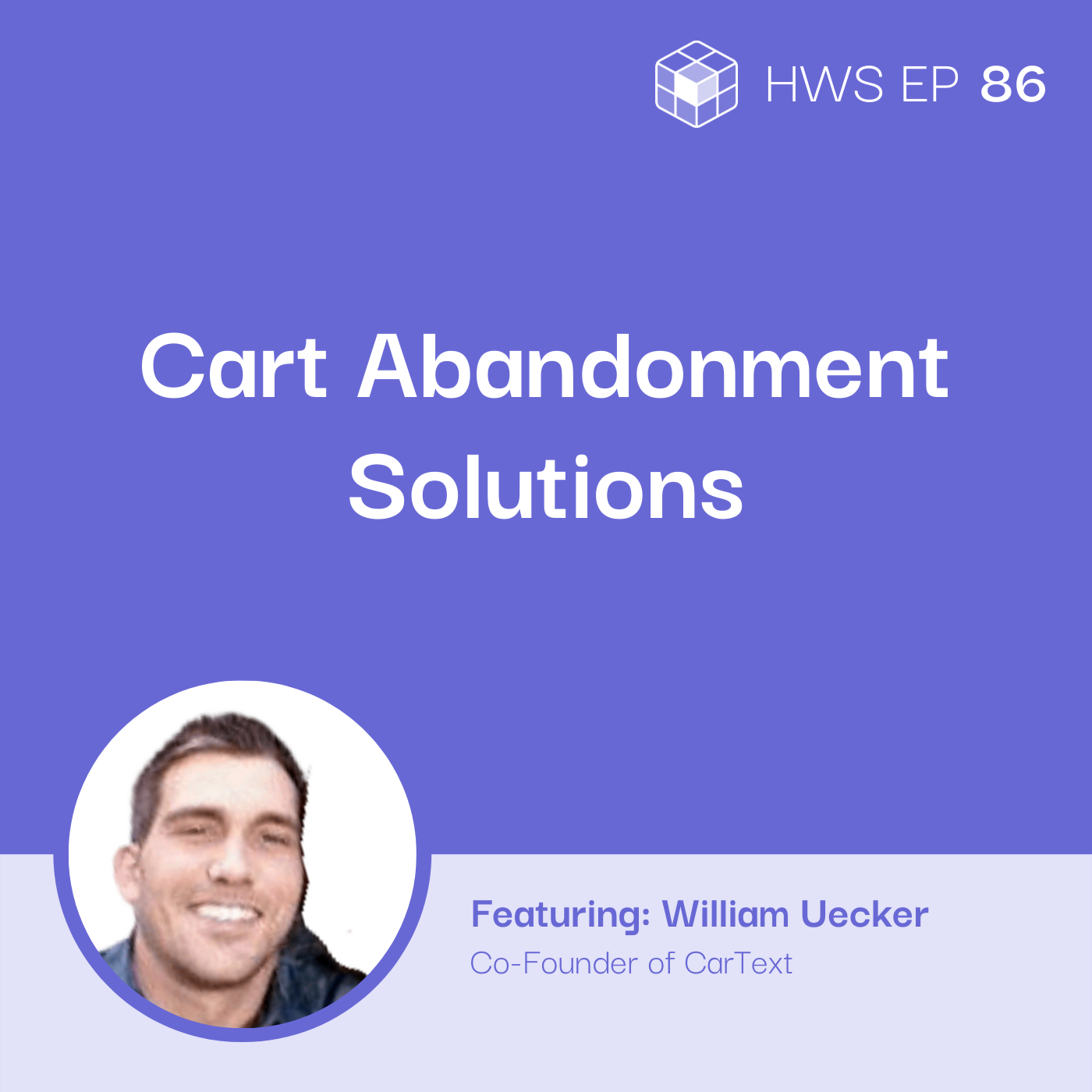Listen on:
Table of Contents:
Problem: How can you increase sales and conversions from your existing customers through personalized SMS?
CNBC reported that approximately 94% of online shopping carts are abandoned during pandemics. Online shopping serves as therapy for customers who are locked up at home. eCommerce brands and companies didn’t realize that they were losing sales due to abandoned checkouts because they rely on automation. CartText’s CEO, William Uecker, shares how to increase sales from this captured customer base through personalized SMS.
“SMS channel is just so personalized. It has a 98% open rate. You know, unlike email channels where you might be lucky to get a 20%. It’s a highly customized and personalized channel.”
Customization and Personalization
Shoppers have different journeys when they buy things online, regardless of the channel they use. The advancement and availability of customer shopping behavior data on platforms are so advanced that they enable CartText to build personalized and customized shopping experiences for the brands with which they work. But how do they create a seamless recovery experience from the time the customers abandon their carts?
Step #1: Understand where the customer is on their shopping journey
There are many reasons why customers leave their carts. Some say it can be attributed to online window shopping, but when you manage your e-commerce platform and make the most out of abandoned carts, you need to look at the checkout experience. Are they checking out particular items? Have they just arrive at the website and left? You need to understand how your customer got down that funnel. Identify which ones are showing genuine interest in your product. Try drilling down further in their experience by:
- Reviewing the items on their cart
- Reaching out and ask if they have questions about the products.
“I like to look at the checkout experience[…] As you go down that funnel, you get more highly targeted consumers that are showing real interest in your product. I just don’t think that automation belongs in a spot where you had someone come to your website, they’ve added a product to cart, they’ve entered all their personal information, and then you’re sending automated messages. That doesn’t make much sense. And so, that’s where we tie in a real live rep that might reach out and say, “Hey, I noticed you had some stuff in your shopping cart or XYZ in your shopping cart. Did you have a question or something I can help with?” When the response comes in, then we can gear that conversation.”
Step #2: Figure Out Their Pain Points
Consultation works best with customers who leave items in their cart because they cannot get the information they need. Educate your representatives on how to reach out to customers using humanized, personalized SMS. Be sure your sales team has a thorough understanding of the products that your customers are checking out when these conversations occur. You’ll be able to earn their trust when they see and receive signals that your representatives understand what’s keeping them from buying the products and what problems they need to solve.
“We’ve done many things in the space to help the brands identify their number one, number two, and number three problems. So, they can make decisive decisions on their checkout on their website. Or to start answering those questions before them ever getting to the event in that process.”
Step #3: Train your product representatives to avoid confusion and organize tool kits to support them
When addressing your customers’ questions and pain points, it’s essential to be consistent in what you say across channels. When your representatives do this, make sure they explain the most minuscule details related to your process, delivery timelines, and the fine print. On top of building trust in your customers, make sure you have readily available, organized materials they can pull out if they encounter questions outside the FAQs. Ensure that there are systems where they can easily pull out files like schedules and calendars to respond as fast as possible.
There’s a lot of confusion around that product. But, our agents have been trained on that particular product well, explaining the process, the timelines and what to expect, and when to expect it. And we’ve increased conversions for that specific company. Like I said, right around the 30%. Our strategic setup of understanding products, consumer pain points, shipping questions, whatever it might be —they’re neatly organized for the agent to search and be able to respond as quickly as possible to the consumer.”
Step #4: Listen to Feedback, Address Complains, Upsell, and Cross-Sell Only When Necessary
Even small comments can provide insight, such as preferences for specific designs or colors. Identifying recurring problems and complaints helps you improve your product, customer journey, and overall user experience. Your representatives should be trained to determine the best product to offer or open the possibility of combining the purchase with another product with which the customer will be happier.
“If you’re not ready and willing to listen to your problems from your customers, then your brand is going to die. Because this is the biggest source for all of your answers, especially the ones that complain, so, I think brands must open their ears and say, “You know what? People don’t like the pink on that Bow tie or whatever”, You know, and so make green, or do polka dots or something. I think at the end of the day, brands really have to be aware of what their consumers are talking about and ready to make decisions to really put the consumer first.
Step #5: Review Past and Present Data; But Be Mindful About Privacy
When anything and everything is measurable, it’s essential to learn how to maximize available data carefully. And William emphasized the mindful use of data. With many big tech companies coming under fire for unethical use of private data, you have to make sure that your SMS and notifications are not intrusive but helpful. Make sure to check and make sense of:
- Current cart contents
- Past order history to predict what they will find valuable
- Recurring problems and similar products they’ve abandoned
That way, you can offer better products.
How did William use his Dyslexia to open opportunities: “First of all, dyslexia to me, Dyslexia was my biggest asset. It allows me to never see dead ends. It just makes me see opportunity and potential. So, all I’m thinking about when I run into a problem, it’s like, am I going to go over it, under it, or around it? I don’t know which way I’m going to do it, but that’s how I’m going to handle my situation. I can’t clump up all us dyslexic in one arena, but, it really is what I believe that gave me an entrepreneurial heart. I’ve never worked for another company, and I’ve always set out to change the world to be a better place. Especially in the e-commerce world.”
This interview is part of the How We Solve podcast. To hear more from industry experts who are solving everyday business problems, check us out on Spotify, Apple Podcasts, and on our website.
About the guest

William Uecker
William Uecker, Co-Founder of CartText. He is a serial entrepreneur who tries to discover alternative ways to accomplish goals. He loves building companies, teams, and investing. William specializes in personalizing SMS marketing.
Listen on:
